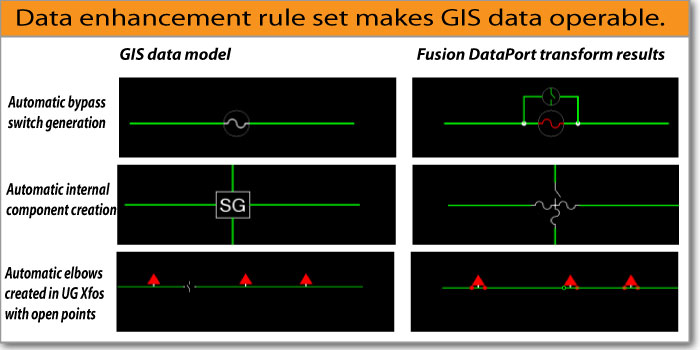JCMB DataPort
Using the connectivity centric functions of Fusion, the DataPort module is used to create sophisticated interfaces to and from different connectivity data models. It excels at implementing automated rules that transform GIS facility objects into fully operable network model
What is a DataPort™ ?
A DataPort is an intelligent Data Sharing Module that interfaces between two or more databases. The intelligence behind the DataPort is that it allows for complex Data Enhancement Rules to be systematically applied to the Data streaming through it. This technique is based on standard ETL (Extract Transform and Load) concepts but is specifically designed to handle Data exchange for utilities focused on Data Intelligence.
DataPort Technology delivers corrected Data – for OMS
GIS systems and their unique Data Models are not usually configured to
deliver Data that meets the stringent requirements imposed by
fault-intolerant Outage Management Systems. Perfect connectivity and
circuits loaded with operable complex device configurations are rarely
modeled in traditional GIS – the DataPort “bridges the gap”.
Data Enhancement Examples: GIS to OMS

| Top: | Adding bypass switches to Reclosers (not usually modeled in GIS – but required by operators) | ||
| Middle: | Generate internal components of a complex device (operators need to operate any switchable device) | ||
| Bottom: | Adding elbows to padmount transformers (elbows not usually part of a GIS Data Model) |
One-Way or Bidirectional DataPort
Technology enables intelligent Data Sharing between various
enterprise systems including: AM/FM/GIS, Work Management, Engineering
Analysis, Outage Management, CIS, DSCADA, Design/Construction and Equipment
Life Cycle Databases.
As a Data Sharing tool, the DataPort can be configured to generate Web-Ready
documents for Intranet or Internet posting.
What are the Benefits of Using a DataPort?
• Configurable
.net technology allows the
DataPort to scale to system demands and new application
requirements.
• Improved Productivity
DataPort
Technology eliminates manual Data correction cycles.
• Increased Automation
DataPort
automation makes use of the latest scheduling and mobile notification
technology – “DataPort text messaging”.
• Improved Data Integrity
The DataPort
features a visualization and test window that allows users to examine and
validate the Data prior to committing it to the target system.
